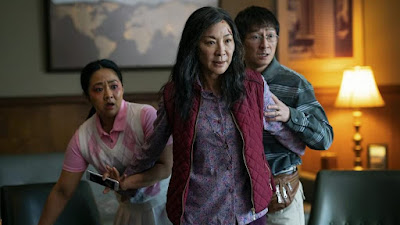Most films are created with an intent. Unless you're doing something avant garde, you're not just throwing stuff at a wall and seeing what sticks. (TV series, on the other hand...) If you're the director, you get a screenplay and think: "This is the film that I want to make." and then proceed into production and casting and everything that's going to make your piece of rock eventually look like an elephant. If you had a competent writer, that piece of rock should already have impressions for trunk, tusks, and tail, but some directors can overcome that absence (and others can ruin the rock when they first take a chisel to it.) With that said, it has to be noted that Everything Everywhere All at Once is a remarkable film, not only for what shows up on the screen, but for the driving vision of co-writers/co-directors Dan Kwan and Daniel Scheinert. No matter what else I may say about it, it has to be clear that I enjoyed it and would probably like to see it again someday. Can I recommend it to everyone as the gushing hordes on Twitter have insisted? Well... no. I think there's something essential that is lacking there that would turn it from "interesting and enjoyable" into "GREATEST FILM EVAAAAAHHH!" as seems to be the popular opinion among many of the younger people I know and hear from. Perhaps the way to explain this without sounding too harsh is to do a comparison.
There's a film called Big Trouble in Little China. It was made during the extended downswing of Jobn Carpenter's career and has a decent-sized cult audience. Amusingly enough, what first made me consider this comparison was when I was sitting in the theater watching EEAaO and noticed that one of its leads was James Hong, who played the wicked Lo Pan (Indeed!) in Big Trouble. Carpenter's film is somewhere between a B-action flick and an intentional farce. With Kurt Russell chewing scenery and Kim Cattrall doing an exposition dump every five minutes, it's not a good film, but I'd argue that it was never intended to be. It's pretty clear about 20 minutes in that both Carpenter and his cast had decided to go full-bore into the absurdity of the situation and let whatever happened, happen. What did happen is that it justly bombed at the box office, but has since developed a following among those who'd seen it and simply appreciated the circus for what it was.
EEAaO is in a similar but not identical situation, in that I think Kwan and Scheinert intended to present a visual spectacle, first and foremost. In that respect, they succeeded. The repeated transitions of Michelle Yeoh through multiple and wildly varying other-dimensional versions of herself is definitely entertaining to watch. You could almost have gone down that more artistic, experimental path that I referenced above and still had something worthwhile to display. But, instead, the filmmakers decided to angle toward a more philosophical bent, constructing an elaborate story that explores all of Evelyn's (Yeoh) personal foibles, relationships, history, and emotions. All of these things are splayed out in often jarring fashion that leaves the audience little room to digest what's happening... until the third act, when all of it is regurgitated again in repetitive, droning, agonizing detail. There is something to be said for a story about a main character who simply fails to register what's right in front of them. Constructing the entire third act of a film about a character who simply refuses to do so is something else entirely.
And that was my main disaffection with the film. As enjoyable and funny and surprising as it could often be, I think the filmmakers lost the thread of what they had begun weaving when they got into it. Big Trouble was clearly intended to be a cult film. It's a circus and you're supposed to just turn your brain off and enjoy it. (Something I often have a very difficult time doing.) But EEAaO presents as a circus, but attempts to drown you in personal metaphor in that third act. Suddenly, everything has deeper meaning and you will be repeatedly instructed on how to absorb said meaning before you leave your seat. It's kind of like an analogy for P.T. Barnum, who is credited with various bits of sage advice from running a carnival and a "museum of oddities" in the 19th century. No matter how sage Barnum could be, in the end, he never held himself up as anything other than a showman trying to squeeze coins from the local audience for coming in to see the freaks. Kwan and Scheinert attempt to attach a very serious underpinning to their circus and it never quite finds its footing. In a way, their story rooted in personal travail and the difficulties of human relationships ends up so overwhelmed by the dizzying array of visuals that it all ends up feeling lighter than it should have been. The story isn't married to the visual storytelling, but is kind of an adjunct that makes the third act longer than it needs to be when it could've been just a great show.
Most of the performances are excellent, with both Yeoh and Jamie Lee Curtis as a menacing IRS auditor particularly standing out. If this elephant could've had a slightly shorter and less onerous tail, I think it would've reached the heights that a lot of others are assigning to it. But that would've been a somewhat different beast (Indeed!)



No comments:
Post a Comment
Note: Only a member of this blog may post a comment.